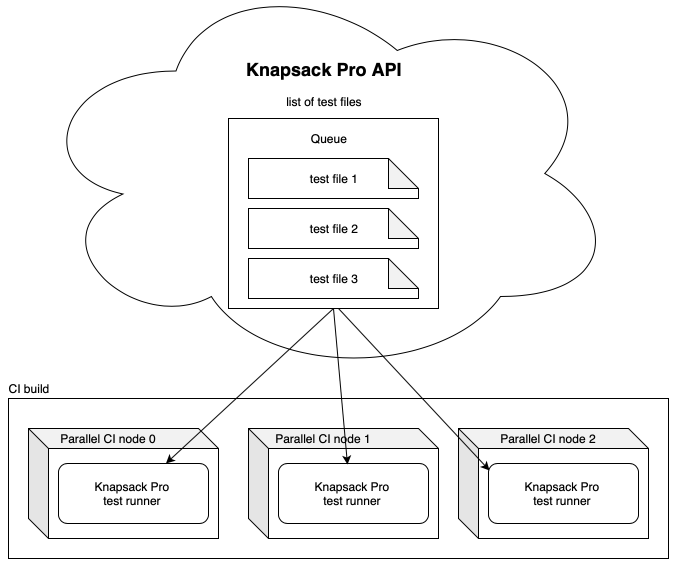Cucumber BDD testing using Github Actions parallel jobs to run tests quicker
Cucumber employs Behavior-Driven Development (BDD) for testing your application. This type of test is often time-consuming when running in the browser. You will learn how to run Cucumber tests on Github Actions using parallel jobs to execute the test suite much faster.

Github Actions matrix strategy
You can use the Github Actions matrix strategy to run parallel jobs. You will need to divide your Cucumber test files between the parallel jobs in a way that work will be balanced out between the jobs.
It’s not that simple to do because often Cucumber tests can take a different amount of time. One test file can have many test cases, the other can have only a few but very complex ones, etc.
There are often more steps in your CI pipeline like installing dependencies, loading data from the cache and each step can take a different amount of time per parallel job before even Cucumber tests are started. The steps affect the overall CI build speed.

What you would like to achieve is to run parallel jobs in a way that they always finish the execution of Cucumber tests at a similar time. Thanks to that you will avoid lagging jobs that could be a bottleneck in your CI build.

Dynamically split Cucumber tests using Queue Mode
To get optimal CI build execution time you need to ensure the work between parallel jobs is split in such a way as to avoid bottleneck slow job.
To achieve that you can split Cucumber test files in a dynamic way between the parallel jobs using Knapsack Pro Queue Mode and knapsack_pro ruby gem.
Knapsack Pro API will take care of coordinating how tests are divided between parallel jobs. On the API side, there is a Queue with a list of your test files and each parallel job on Github Actions is running Cucumber tests via the knapsack_pro Ruby gem. The knapsack_pro gem asks Queue API for a set of test files to run and after it gets executed then the gem asks for another set of test files until the Queue is consumed. This ensures that all parallel jobs finish running tests at a very similar time so that you can avoid bottleneck jobs.

You can learn more about the dynamic tests suite split in Queue Mode or check the video below.
Github Actions parallel jobs config for Cucumber
Here is the full Github Actions YAML config example for the Cucumber test suite in a Ruby on Rails project using knapsack_pro gem to run Cucumber tests between parallel jobs.
# .github/workflows/main.yml
name: Main
on: [push]
jobs:
test:
runs-on: ubuntu-latest
# If you need DB like PostgreSQL, Redis then define service below.
# https://github.com/actions/example-services/tree/main/.github/workflows
services:
postgres:
image: postgres:10.8
env:
POSTGRES_USER: postgres
POSTGRES_PASSWORD: ""
POSTGRES_DB: postgres
ports:
- 5432:5432
# needed because the postgres container does not provide a healthcheck
# tmpfs makes DB faster by using RAM
options: >-
--mount type=tmpfs,destination=/var/lib/postgresql/data
--health-cmd pg_isready
--health-interval 10s
--health-timeout 5s
--health-retries 5
redis:
image: redis
ports:
- 6379:6379
options: --entrypoint redis-server
# https://docs.github.com/en/actions/writing-workflows/workflow-syntax-for-github-actions#jobsjob_idstrategymatrix
strategy:
fail-fast: false
matrix:
# Set N number of parallel jobs you want to run tests on.
# Use higher number if you have slow tests to split them on more parallel jobs.
# Remember to update ci_node_index below to 0..N-1
ci_node_total: [8]
# set N-1 indexes for parallel jobs
# When you run 2 parallel jobs then first job will have index 0, the second job will have index 1 etc
ci_node_index: [0, 1, 2, 3, 4, 5, 6, 7]
steps:
- uses: actions/checkout@v2
- name: Set up Ruby
uses: actions/setup-ruby@v1
with:
ruby-version: 2.7
- uses: actions/cache@v2
with:
path: vendor/bundle
key: ${{ runner.os }}-gems-${{ hashFiles('**/Gemfile.lock') }}
restore-keys: |
${{ runner.os }}-gems-
- name: Bundle install
env:
RAILS_ENV: test
run: |
bundle config path vendor/bundle
bundle install --jobs 4 --retry 3
- name: Create DB
env:
# use localhost for the host here because we have specified a container for the job.
# If we were running the job on the VM this would be postgres
PGHOST: localhost
PGUSER: postgres
RAILS_ENV: test
run: |
bin/rails db:prepare
- name: Run tests
env:
PGHOST: localhost
PGUSER: postgres
RAILS_ENV: test
KNAPSACK_PRO_TEST_SUITE_TOKEN_CUCUMBER: ${{ secrets.KNAPSACK_PRO_TEST_SUITE_TOKEN_CUCUMBER }}
KNAPSACK_PRO_CI_NODE_TOTAL: ${{ matrix.ci_node_total }}
KNAPSACK_PRO_CI_NODE_INDEX: ${{ matrix.ci_node_index }}
KNAPSACK_PRO_FIXED_QUEUE_SPLIT: true
KNAPSACK_PRO_LOG_LEVEL: info
run: |
bundle exec rake knapsack_pro:queue:cucumberHere is the view from Github Actions showing that we run 8 parallel jobs for the CI build.

Summary
I hope you find this example useful. If you would like to learn more about Knapsack Pro please check our homepage and see a list of supported test runners for parallel testing in Ruby, JavaScript, etc.